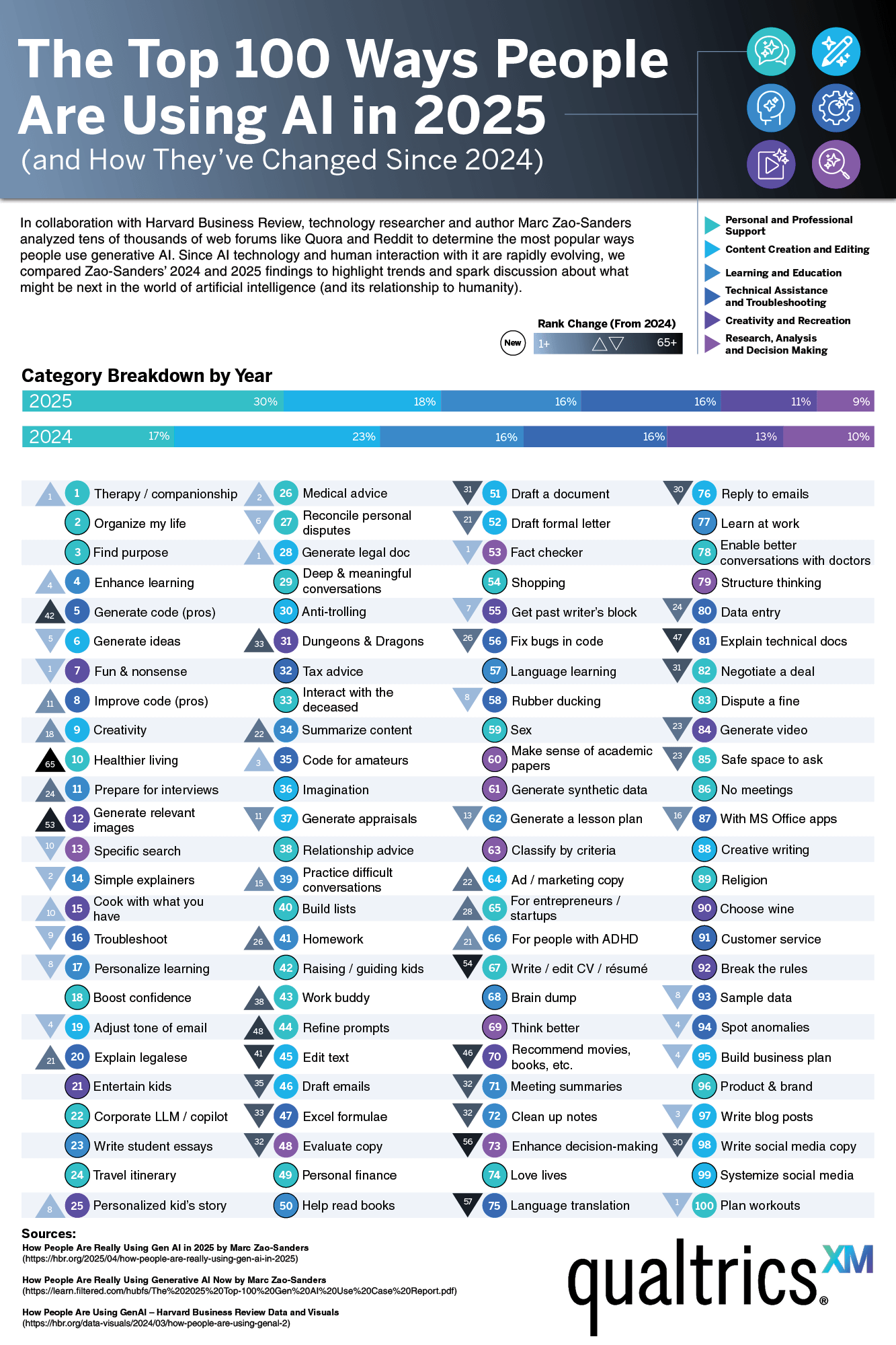Business Visualizations
Study Shows Where the Oldest and Youngest Business Owners Live
There are many kinds of entrepreneurs in the U.S., from family-owned restaurants to tech startups. The team at Ooma studied data on the ages of business owners in every state, then mapped out the results to identify any regional patterns. As we can see from the map, business ownership aspirations aren’t limited to a certain age. The team used data from the U.S. Census Bureau to create their map and examined major metropolitan areas to determine where the oldest and youngest business owners reside.
Click below to zoom.
The youngest business owners live in Provo-Orem-Lehi, Utah, where the average age of a business owner is a bit below 49. This is lower than the national average by about a decade. Overall, many young entrepreneurs live in Utah. This could be due to the low cost of living and a family-focused culture with plenty of support for younger business owners. Utah’s economic boom surely helps these businesses get off the ground.
These ten cities have the youngest business owners in the country:
- Provo-Orem-Lehi, Utah
- Bozeman, Montana
- Fargo, North Dakota-Minnesota
- Logan, Utah-Idaho
- Ogden, Utah
- George, Utah
- Salt Lake City-Murray, Utah
- Boise City-Idaho
- Lancaster, Pennsylvania
- Kennewick-Richland, Washington
Utah certainly claimed many spots on this list, but we also see that the Rockies and Upper Midwest support a lot of young business owners. University towns and low living costs all help support younger people in gathering the resources to start their own business.
Moving on to the cities with the oldest business owners, we find that Santa Fe, New Mexico, has the oldest business owners, with an average age of around 59 years. Many of the cities topping this list are located in retirement-friendly areas with slower population growth and higher cost of living. This suggests these are more difficult locations to start a small business in, requiring owners to have more resources and experience to get started.
These ten cities have the oldest business owners:
- Santa Fe, New Mexico
- Napa, California
- Monroe, Louisiana
- Kingston, New York
- Urban Honolulu, Hawaii
- Youngstown-Warren, Ohio
- Bridgeport-Stamford-Danbury, Connecticut
- Scranton-Wilkes-Barre, Pennsylvania
- Hilton Head Island-Bluffton-Port Royal, South Carolina
- Trenton-Princeton, New Jersey
According to the national data the team collected, most business owners are in their late 40s to early 50s. This might surprise some people, as the media often reports on bright young entrepreneurs founding exciting tech startups. However, consider that there are many different types of small businesses in America. In most cases, starting a successful business requires resources, time, and connections that can only be acquired through age and experience. In general, the spread of ages isn’t very large, so it seems the team has pinpointed the ideal age to start up a business.
This map can provide valuable insights into the American economy, both by region and as a whole. While the team identified some regional patterns in entrepreneurship, it appears that entrepreneurs across the nation share many commonalities.
Business Visualizations
The Largest Companies in America That Are Still Run by the Person Who Founded Them
In the corporate world, leadership changes are practically expected. CEOs come and go, boards shuffle seats, and strategies pivot with the seasons. For most large corporations, the founding vision eventually gives way to the influence of successors, but every once in a while, a company manages to scale the peaks of the Fortune 1000 while still being led by the very person who dreamed it up in the first place.
Going from running a business out of your garage to managing a multi-billion-dollar operation requires an impressive mix of genius, grit, and endurance that most would struggle to sustain across decades of board meetings, bold bets, and bottom-line pressure.
So, what does it take to build a business worth billions and still be the one calling the shots? To find out, our team at The Chartistry has pulled together a graphic that maps out the largest companies in the U.S. that are still being run by the same people who started them.
Click below to zoom.
Tech Giants Still Calling the Shots
The tech industry can be a volatile market, especially when billions of dollars are at stake every year, making founder-CEOs in this space a rare species. Mark Zuckerberg, founder and CEO of Facebook (now Meta), is a headline example. From the scrappy days of coding in his Harvard dorm to overseeing Meta’s $134.9 billion revenue machine, he hasn’t let go of the reins. His company now ranks 30th on the Fortune 1000 list, but it continues to operate under the umbrella of Zuckerberg’s vision.
Jensen Huang of NVIDIA is another powerhouse. He co-founded the company in 1993 and continues to lead it as CEO and President. NVIDIA is now a central player in the AI boom, raking in over $60.9 billion in 2024. The company landed at #65 on the Fortune list, and much of that momentum can be traced back to Huang’s technical savvy and leadership style.
Another founder-CEO of a big tech company is Michael Dell. After founding Dell Technologies in 1984, Dell stepped away briefly before returning to steer the company through its privatization and subsequent return to public markets. With $88.43 billion in revenue, it holds spot #48 on the list.
Long-Hauler Founders of the Biggest U.S. Companies
Wall Street can be brutal, yet some of the longest-tenured company founders make the ranks in this industry. Richard Fairbank has run Capital One since 1987, long before online banking was the norm. Under his leadership, the company pulled in $49.48 billion last year.
Larry Fink’s story is equally impressive. He co-founded BlackRock in 1988 and helped turn it into the world’s largest asset manager. It now generates $17.86 billion annually.
Then there’s Mark Millett, who co-founded Steel Dynamics in 1993. It might not make splashy headlines like tech and finance, but this steel manufacturer generated $18.8 billion last year, proving that innovation can lead to immense success in any space.
Is Elon Musk Actually the Founder of Tesla?
Elon Musk is arguably the most high-profile figure on the list, but his relationship with Tesla’s origins is less straightforward than the others on our list. Tesla was actually founded by Martin Eberhard and Marc Tarpenning in 2003. Musk joined shortly after as an investor and took a more active role over time. It wasn’t until a legal settlement in 2009 that Musk was “officially” determined to be a co-founder, along with four others. Today, he serves as the CEO and public face of Tesla, a company that posted $96.77 billion in revenue in 2024.
Why Are They Still Here?
While circumstances vary and some CEO-Founders stick around long after what’s best for the company, research seems to support that many of them remain the right person for the job. A Harvard Business Review study found that companies led by their founders outperformed others in market valuation by 10% over the long term. Especially in the early days when the potential rewards are higher, founders tend to prioritize innovation, take bigger strategic bets, and maintain a stronger emotional commitment to the company’s mission.
Additionally, founder-CEOs often make faster decisions, have deeper customer intuition, and are more adaptable when navigating new markets. These traits help fuel long-term growth and can serve as a stabilizing force in times of disruption. That said, success depends on their ability to scale alongside the business. The most effective founders seem to grow their leadership style as the company matures, surrounding themselves with experienced teams while staying grounded in the original vision.
In many cases, large companies will also adopt dual-class stock structures, which help founders maintain some control even as ownership becomes more distributed.
Out of the 1,000 biggest companies in America, only 59 are still run by their founders. Amounting to less than 6 percent, it’s both inspiring and daunting how successful many of their companies have become.
Along with shaping industries and building legacies, they’re keeping their original visions alive in a world that often trades the leadership of innovative founders for business-savvy executives. Their stories serve as a reminder that leadership is about commitment and conviction as much as it is about keeping a business running.
At The Chartistry, we know that there’s a great story behind every dataset. Explore more trends in executive leadership, company growth, and market innovation in America’s largest companies on our Business Visualization page. Or, if you’re looking for more inspiring stories of success, check out our Finance Visualizations.
Founders of Major Corporations Still Serving as CEO
The list of America’s largest companies that are still run by the person who founded them is based on data from Fortune’s list of the 1,000 biggest companies in the United States. Just 59 of the 1,000 biggest U.S. companies are still run by the person who founded them. The founder must be the current Chief Executive Officer (CEO) of the company, as of June 2025, to be included.
| Rank | Company | Forbes 1000 Rank (as of July 2024) |
Revenue in Billions (as of July 2024) |
CEO Name | Year Founded | Title (as of June 2025) |
| 1 | Meta Platforms | 30 | $134.90 | Mark Zuckerberg | 2004 | Co-Founder, CEO, Chairman |
| 2 | Tesla | 40 | $96.77 | Elon Musk | 2003 (Musk was designated as one of five co-founders in 2009 via a settlement.) |
Co-Founder, CEO |
| 3 | Dell Technologies | 48 | $88.43 | Michael Dell | 1984 | Founder, CEO, Chairman |
| 4 | NVIDIA | 65 | $60.92 | Jensen Huang | 1993 | Co-Founder, CEO, President |
| 5 | Capital One Financial | 91 | $49.48 | Richard Fairbank | 1987 | Co-Founder, CEO, Chairman |
| 6 | Salesforce | 123 | $34.86 | Marc Benioff | 1999 | Co-Founder, CEO, Chairman |
| 7 | Apollo Global Management | 136 | $32.64 | Marc Rowan | 1990 | Co-Founder, CEO, Chairman |
| 8 | Coupang | 168 | $24.38 | Bom Kim | 2010 | Founder, CEO, Chairman |
| 9 | Block | 186 | $21.92 | Jack Dorsey | 2009 | Co-Founder, CEO, Chairman |
| 10 | Steel Dynamics | 221 | $18.80 | Mark Millett | 1993 | Co-Founder, CEO, Chairman |
| 11 | BlackRock | 231 | $17.86 | Larry Fink | 1988 | Co-Founder, CEO, Chairman |
| 12 | Regeneron Pharmaceuticals | 311 | $13.12 | Leonard Schleifer | 1988 | Co-Founder, CEO, President, Co-Chairman |
| 13 | Wayfair | 346 | $12.00 | Niraj Shah | 2002 | Co-Founder, CEO, Co-Chairman |
| 14 | Carvana | 377 | $10.77 | Ernest Garcia III | 2012 | Co-Founder, CEO, President, Chairman |
| 15 | Airbnb | 396 | $9.92 | Brian Chesky | 2008 | Co-Founder, CEO |
| 16 | Intercontinental Exchange | 397 | $9.90 | Jeffrey Sprecher | 2000 | Founder, CEO, Chairman |
| 17 | Sanmina | 433 | $8.94 | Jure Sola | 1980 | Co-Founder, CEO, Chairman |
| 18 | DoorDash | 443 | $8.64 | Tony Xu | 2013 | Co-Founder, CEO |
| 19 | Prologis | 463 | $8.02 | Hamid Moghadam | 1983 | Co-Founder, CEO, Chairman |
| 20 | Blackstone | 464 | $8.02 | Stephen Schwarzman | 1985 | Co-Founder, CEO, Chairman |
| 21 | Skechers U.S.A. | 465 | $8.00 | Robert Greenberg | 1992 | Founder, CEO, Chairman |
| 22 | Super Micro Computer | 498 | $7.12 | Charles Liang | 1993 | Co-Founder, CEO, Chairman, President |
| 23 | Insperity | 541 | $6.49 | Paul Sarvadi | 1986 | Co-Founder, CEO, Chairman |
| 24 | Under Armour | 577 | $5.90 | Kevin Plank | 1995 | Founder, CEO, Chairman, President |
| 25 | SS&C Technologies Holdings | 600 | $5.50 | William Stone | 1986 | Founder, CEO, Chairman |
| 26 | Fortinet | 622 | $5.31 | Ken Xie | 2000 | Founder, CEO, Chairman |
| 27 | Urban Outfitters | 635 | $5.15 | Richard Hayne | 1970 | Co-Founder, CEO, Chairman |
| 28 | Ares Management | 644 | $4.99 | Michael Arougheti | 1997 | Co-Founder, CEO, Director |
| 29 | Nexstar Media Group | 648 | $4.93 | Perry Sook | 1996 | Founder, CEO, Chairman |
| 30 | Compass | 654 | $4.89 | Robert Reffkin | 2012 | Co-Founder, CEO |
| 31 | EPAM Systems | 669 | $4.69 | Arkadiy Dobkin | 1993 | Co-Founder, CEO, Chairman, President |
| 32 | Antero Resources | 670 | $4.68 | Paul Rady | 2002 | Co-Founder, CEO, Chairman, President |
| 33 | Snap | 679 | $4.61 | Evan Spiegel | 2011 | Co-Founder, CEO, Director |
| 34 | Zoom Video Communications | 683 | $4.53 | Eric Yuan | 2011 | Founder, CEO, Chairman, President |
| 35 | Rivian Automotive | 692 | $4.43 | RJ Scaringe | 2009 | Founder, CEO |
| 36 | PriceSmart | 697 | $4.41 | Robert Price | 1993 | Co-Founder, CEO (until Sept. ‘25), Chairman |
| 37 | eXp World Holdings | 708 | $4.28 | Glenn Sanford | 2008 | Founder, CEO, Chairman |
| 38 | Toast | 766 | $3.87 | Aman Narang | 2012 | Co-Founder, CEO, Director |
| 39 | Akamai Technologies | 771 | $3.81 | Dr. Tom Leighton | 1998 | Co-Founder, CEO |
| 40 | ScanSource | 776 | $3.79 | Michael Baur | 1992 | Co-Founder, CEO, Chairman |
| 41 | Dream Finders Homes | 784 | $3.75 | Patrick Zalupski | 2008 | Co-Founder, CEO, Chairman, President |
| 42 | Century Communities | 794 | $3.69 | Robert Francescon | 2002 | Co-Founder, CEO, President, Director |
| 43 | Euronet Worldwide | 796 | $3.69 | Michael Brown | 1994 | Co-Founder, CEO, Chairman, President |
| 44 | DraftKings | 798 | $3.67 | Jason Robins | 2011 | Co-Founder, CEO, Chairman |
| 45 | Atlassian | 811 | $3.54 | Mike Cannon-Brookes | 2002 | Co-Founder, CEO |
| 46 | Roku | 820 | $3.49 | Anthony Wood | 2002 | Founder, CEO, Chairman |
| 47 | Cheesecake Factory | 828 | $3.44 | David Overton | 1972 | Co-Founder, CEO, Chairman |
| 48 | Chefs’ Warehouse | 830 | $3.43 | Christopher Pappas | 1985 | Co-Founder, CEO, Chairman, President |
| 49 | AppLovin | 847 | $3.28 | Adam Foroughi | 2012 | Co-Founder, CEO, Chairman |
| 50 | PACS Group | 869 | $3.11 | Jason Murray | 2013 | Co-Founder, CEO, Chairman |
| 51 | Coinbase Global | 870 | $3.11 | Brian Armstrong | 2012 | Co-Founder, CEO, Chairman |
| 52 | CrowdStrike | 883 | $3.06 | George Kurtz | 2011 | Founder, CEO |
| 53 | Matador Resources | 930 | $2.81 | Joseph Wm. Foran | 2003 | Founder, CEO, Chairman |
| 54 | Viasat | 932 | $2.80 | Mark Dankberg | 1986 | Co-Founder, CEO, Chairman |
| 55 | Roblox | 935 | $2.80 | David Baszucki | 2004 | Co-Founder, CEO |
| 56 | ProFrac Holding | 971 | $2.63 | Ladd Wilks | 2016 | Co-Founder, CEO |
| 57 | Playtika Holding | 982 | $2.57 | Robert Antokol | 2010 | Co-Founder, CEO, Chairman |
| 58 | Stagwell | 993 | $2.53 | Mark Penn | 2021 | Founder, CEO, Chairman |
| 59 | Dropbox | 997 | $2.50 | Drew Houston | 2007 | Co-Founder, CEO |
Sources:
Corporate Websites
Business Visualizations
The Top 100 AI Uses in 2025
The team at Qualtrics released a fascinating new study on the 100 most common ways people are using AI in 2025. They gathered their data from the Harvard Business Review and showed how each use rose or fell in popularity since 2024. As AI continues to grow, improve, and infiltrate more areas of life, these uses are sure to change. But this graphic serves as a great study of the state of AI usage in 2025. Netizens can use this chart to get inspiration for incorporating AI into their next project or use it as a reference when studying AI’s impact on society.
Click below to zoom.
The team found that AI use could be separated into six broad categories. Here are the areas, along with how much use has increased since 2024:
Personal and Professional Support
- 30% (up from 17% in 2024)
Content Creation and Editing
- 18% (down from 23% in 2024)
Learning and Education
- 16% (steady from 2024)
Technical Assistance and Troubleshooting
- 16% (steady from 2024)
Creativity and Recreation
- 11% (down from 13% in 2024)
Research, Analysis and Decision Making
- 9% (down from 10% in 2024)
The most popular and fastest-growing category of AI use is in personal and professional support. This category can encompass many different ways to use AI, such as scheduling, planning workouts, prepping for job interviews, organizing life, and even as a coach through parenting and interpersonal challenges. In fact, the number one use for AI in 2025 is as a therapist or counselor. Many professionals are concerned about this widespread use for therapy since an AI can’t think or empathize as a human can. The average AI user may not realize that AI is a predictive text model that bases its responses on probability and statistics rather than logic and compassion.
Although this use case is declining, many people still use AI for content creation and editing. This can include composing emails and social media posts, experimenting with blogging and creative writing, creating ad copy, structuring business plans, and more. AI is also used to check for errors and refine tone and writing style. Many value preserving their human voice, and this use case has fallen in ranking.
AI is often used for tech assistance, with an increasing number of people using it to create code. AI’s ability to develop workable HTML or automate IT tasks and debug human-written code has vastly improved, so it’s no surprise this use has gained popularity over the past year. AI can be used for less serious purposes, too. People like to experiment with ideas and gain inspiration from AI technology. They use it to compose poems and bedtime stories, get recipe ideas, or plan their next Dungeons and Dragons campaign.
This graphic makes it clear that AI and its uses are constantly evolving to serve people in new ways and adapt to the changing needs of different users. It’s sure to change and adapt in ways we won’t always predict.
Business Visualizations
Study Identifies the Best Cities for First-Time Real Estate Investors
People who want to jump into the real estate investment market have an important question to contend with: Which city should they invest their money in? The team at LLC Attorney has arrived with answers in their new study, which condenses tons of information on the real estate market to identify the 50 best cities for first-time investors. Each town has its own unique characteristics, benefits, and setbacks, but as the team proves, they each offer a powerful incentive for real estate investors.
The team started their study by pulling the 100 most populated cities from the Real Estate Investment Index and pinpointing their 50 ideal cities. The towns on their list are affordable, have high rental income potential, and have landlord-friendly laws. To create their list, the team considered state-level laws on rentals, rent-controlled cities, and the job market in each location. Their potential rental income calculations are based on average monthly rent, median home sale price, gross rental yield, and the market temperature. As for landlord-friendliness, the team considered average eviction time, security deposit limit, and rent control laws.
Click below to zoom.
Out of all 50 cities, the team determined that Port St. Lucie, Florida, is the best city for first-time real estate investors to buy property. This growing city shows no signs of slowing, with median property sale prices lower than other major Florida cities, like Miami and Tampa. The job market in Port St. Lucie is strong in healthcare and education, and business-friendly for entrepreneurs. These factors all combine to represent a city that’s attracting more residents every day. It will be a reliable source of rental income for investors.
Cape Coral, Florida, took the second-place spot for similar reasons. Low property taxes, a growing population, and residents flocking to beaches and parks for seasonal living push up the Cape Coral housing demand and rental potential. The lone midwestern city in the top four is Cleveland, Ohio, drawing in investors with affordable housing and lots of demand because of the strong employers based in this lakeside city. Garland, Texas, comes in fourth with more affordable housing than neighboring Dallas, while still located close to all the dining and entertainment that Dallas offers. Popular Garland employers include FedEx, Interceramic USA, Presbyterian Hospital, and Arena Brands, Inc.
In addition to focusing on the 50 cities the team lists, they suggest that first-time investors look to more seasoned investors for advice. Many expert investors speak at conferences, publish guidebooks, and produce educational videos to share their knowledge. Networking with fellow investors is another great way for new investors to gain support and learn quickly. There are countless networking opportunities on social media and in local groups like your local chamber of commerce. Last, investors need to decide whether they’re looking to buy property close to home that they can maintain themselves, or property far away, in which case they’ll need to hire a property manager. No matter your path, the LLC Attorney team offers a great start with this data.
-
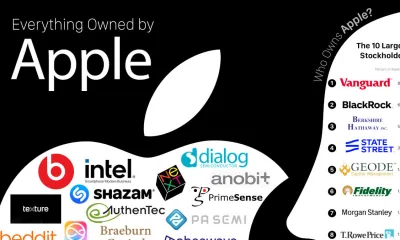
 Business Visualizations1 year ago
Business Visualizations1 year agoEverything Owned by Apple
-
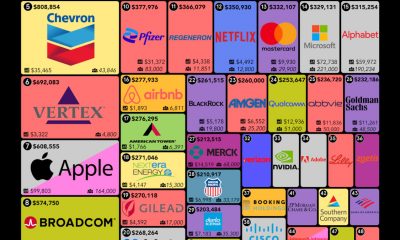
 Business Visualizations12 months ago
Business Visualizations12 months agoAmerica’s Most Valuable Companies Ranked by Profit per Employee
-
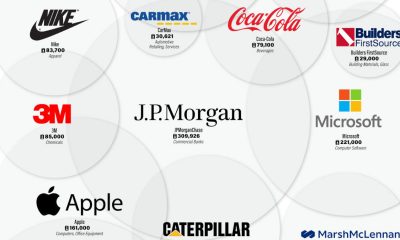
 Business Visualizations5 months ago
Business Visualizations5 months agoThe Biggest Employers by Industry
-
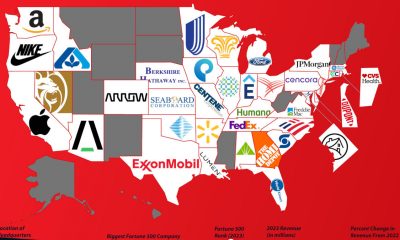
 Business Visualizations8 months ago
Business Visualizations8 months agoThe Biggest Fortune 500 Company in Every State
-
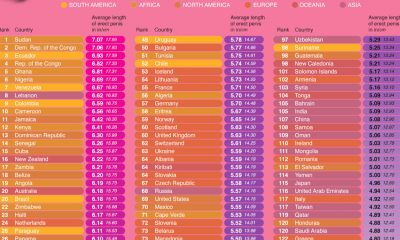
 Maps2 years ago
Maps2 years agoPenis Lengths Around the World
-
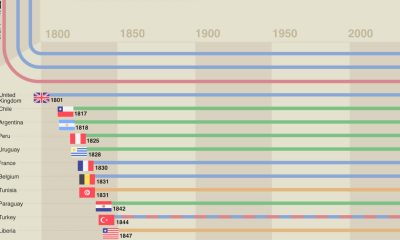
 Timelines2 years ago
Timelines2 years agoA History of the Oldest Flags in the World
-
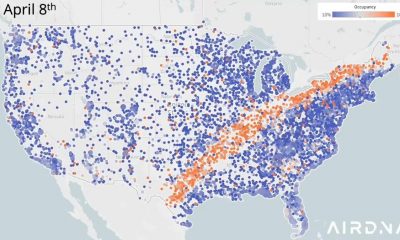
 Business Visualizations2 years ago
Business Visualizations2 years agoNew Animated Map Shows Airbnb’s Fully Booked Cities Along the 2024 Eclipse Path of Totality
-

 Business Visualizations2 years ago
Business Visualizations2 years agoAll The Brands Owned By PepsiCo



